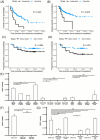Fusobacterium is toxic for head and neck squamous cell carcinoma and its presence may determine a better prognosis
- PMID: 38970403
- PMCID: PMC11337922
- DOI: 10.1002/cac2.12588
Fusobacterium is toxic for head and neck squamous cell carcinoma and its presence may determine a better prognosis
Conflict of interest statement
The authors declare no competing interests.
Figures

References
-
- Sambasivan K, Sassoon I, Thavaraj S, Kennedy R, Doss G, Michaelidou A, et al. TNM 8 staging is a better prognosticator than TNM 7 for patients with locally advanced oral cavity squamous cell carcinoma treated with surgery and post‐operative radiotherapy. Radiother Oncol. 2021:160:54–60. - PubMed
-
- Reis Ferreira M, Pasto A, Ng T, Patel V, Guerrero Urbano T, Sears C, et al. The microbiota and radiotherapy for head and neck cancer: what should clinical oncologists know? Cancer Treat Rev. 2022:109:102442. - PubMed
-
- Bronzato JD, Bomfim RA, Edwards DH, Crouch D, Hector MP, Gomes BPFA. Detection of Fusobacterium in oral and head and neck cancer samples: A systematic review and meta‐analysis. Arch Oral Biol. 2020:112:104669. - PubMed
Publication types
MeSH terms
Grants and funding
LinkOut - more resources
Full Text Sources
Medical

